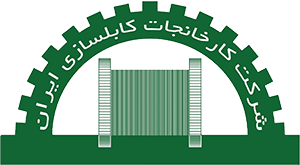The different stages of production are as follows:
1- Joinery
The operation is performed in two steps by a rod thinner and a finer thinner.
In the first stage, the 8mm copper wire is converted to a radius of 10mm by a rad machine, and these wires are transformed into fines suitable for customer order, as the input to the second stage of joining.
2- Annealing phase
All the wires in the fin machine are collected at the specified location next to the annealing furnace, according to the relevant panel and, after reaching the minimum number required for annealing (54 sheets), are ready to be annealed and annealed.
5- Bunch Stage
This operation is performed by the batch machine. The raw materials of this stage are annealed wires on the pulley and if the number of pulleys and their number is in accordance with the customer’s standard order, –
4- Insulation stage (Cable-wire manufacturing)
At this point, the punched filaments are used as the main raw material and the insulated granule as the other main material for the production of wire or cable. The product produced by the extruder machine is sent to the relevant unit for packaging if the end product is a wire and If they are corded, they are mounted on special reels for use in the cantilever (strand) phase.
5- Lining stage (extruder cable)
Extruder machines are used for coating operations. The main raw materials for this step are the extruded granules of the coated granules and powder coatings. How to set up and manufacture the cable is as follows.
6 – Packaging step
This last stage of production is the final product packaged in a variety of shapes and sizes that the customer has requested. Manufactured wire and cable are delivered to the customer in both pulley and coil form.
The packing is also done according to the Nilex customer’s request, but is automatically vacuumed by the packaging machine in the form of wire and cable housings.
Overall process of cable production in Iran:
Given that the cable manufacturing process has a very complex and long cycle and is briefly described in Chapter I, we briefly define the cable and cable production cycle in this chapter.
Initially, the 8mm copper wire, which is wrapped in large pulleys by a forklift on a special platform, first enters the rod puller. Reached 1.38 mm in the pulley is called a mold and is then wrapped in large diameters. Because of the light, heat, and heat generated, all stretchers are lubricated by cold water and soap.
The fluid is injected into a single cycle into all operating devices and returned to the main tank by means of communication pipes, and this cycle is repeated.
The 1.38mm wires are transported to secondary or fin stretchers where they are converted into wire rods / rollers of 0.185, 0.24, 0.28, 0.237 and 0.375 due to conversion to different diameters of manufacture. There are different types of sprinkler diameters available in the market.
After this step, the wire pulleys inside the steel tank furnace arranged by the electric crane are driven into the annealing furnace. Heat treatment causes the wire to lose its dryness and soften so that it does not break in the bunching machine when twisting and twisting.
After the heat treatment, the pulleys are arranged on a platform that is closed off to the pf
The bunching machine is driven. The bunching machine is responsible for shining thin strings of wire
It is mounted inside a pulley bunching machine to wrap its wrapped wires.
The next step is to cover the wire with a plastic insulator which is done by an extruder.
The polyethylene and paint materials are melted by the extruder and applied to the sheathing wires and then passed through the water to cool. The wires are inserted into the printing machine after being coated and the specifications of the wire and the manufacturer are printed on it. In order to produce different wires, the number of filaments and other specifications must be precisely determined.
The wires are driven to the wrench after production. The machine is responsible for sorting the wires into 100-meter sheets. There are platforms at all stages of production that prevent the wires from being tied.
One of the most important stages of wire production is the quality control stage and the laboratory that must be present in each factory. At this stage the electrical resistance of the conductor wire and its coating, resistance to cold and tensile stress, etc. are tested and after market approval.



